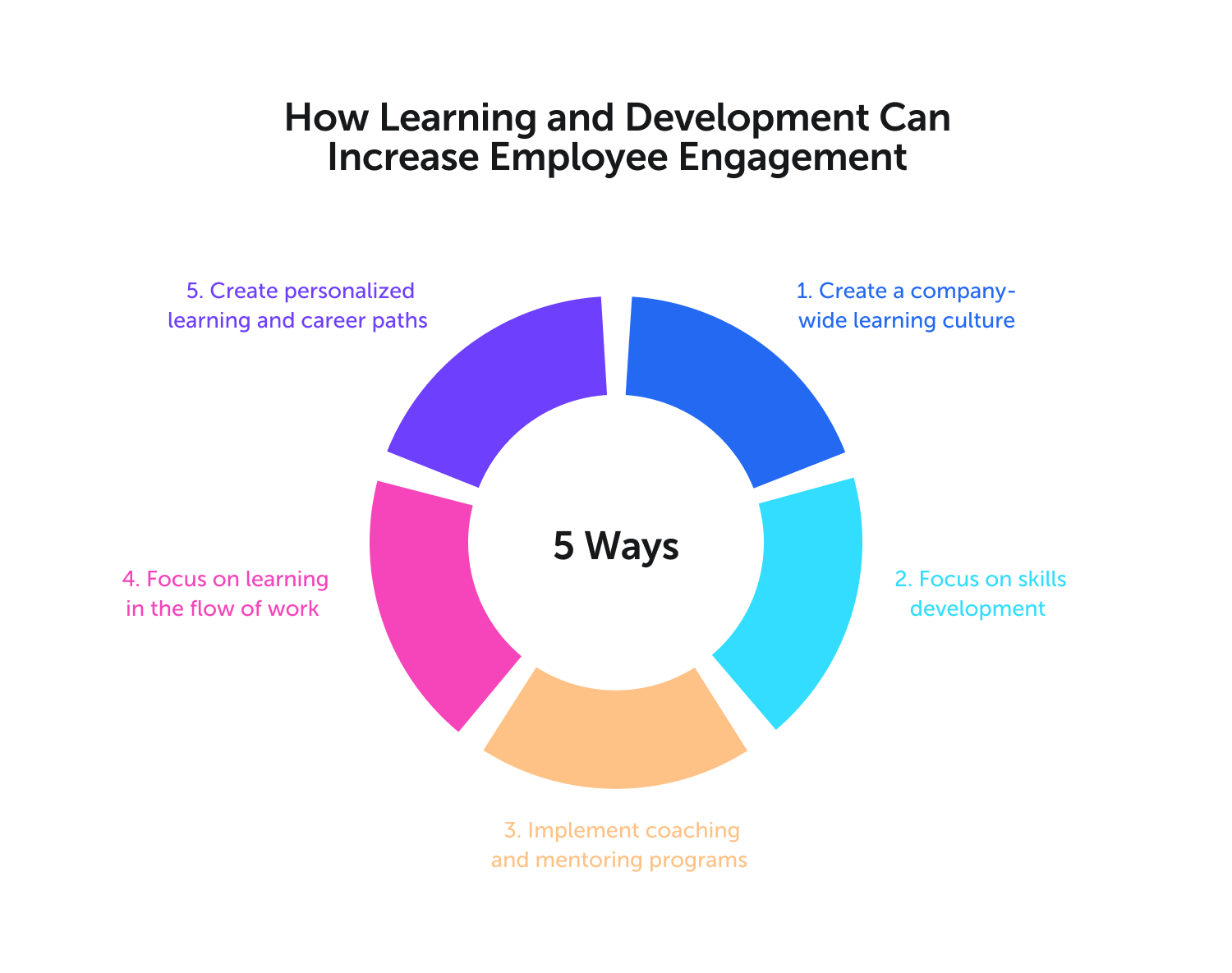How To Improve Employee Engagement?
To improve employee engagement, implement effective communication and recognize their accomplishments. Improving employee engagement involves establishing open lines of communication and regularly acknowledging employees’ achievements and contributions.
Employee engagement plays a crucial role in driving organizational success and productivity. Engaged employees are more likely to perform at their best, feel motivated, and have a higher level of job satisfaction. On the other hand, disengagement can lead to decreased productivity, increased turnover rates, and a negative work environment.
To enhance employee engagement, organizations should prioritize effective communication. Establishing open lines of communication enables employees to feel heard, understood, and involved in decision-making processes. Regularly providing feedback, both positive and constructive, also contributes to increased engagement. Recognizing employees’ accomplishments is another key aspect of enhancing engagement. Celebrating milestones and acknowledging individuals for their contributions and hard work creates a positive work culture, boosts morale, and motivates employees to strive for excellence. To improve employee engagement, it is essential to prioritize effective communication and recognition of accomplishments. By implementing these strategies, organizations can create a positive work environment that fosters engagement, productivity, and overall success.

Credit: www.valamis.com
Create A Positive Work Environment
The key to improving employee engagement is to create a positive work environment, where employees feel valued, supported, and motivated. A positive work environment not only helps in retaining top talent but also enhances productivity and fosters a culture of collaboration and innovation.
Strongestablish Strong Leadership/strong
- Lead by example: Demonstrate the qualities you expect from your employees, such as integrity, professionalism, and a positive attitude.
- Provide clear direction: Clearly communicate goals, expectations, and performance metrics to ensure everyone is on the same page.
- Empower employees: Delegate authority and grant autonomy, allowing individuals to make decisions and take ownership of their work.
- Recognize and reward: Acknowledge and reward employees’ efforts and achievements to boost morale and motivation.
Strongencourage Open Communication/strong
- Promote regular feedback: Create opportunities for employees to give and receive feedback, enabling them to grow and improve.
- Listen actively: Show genuine interest and engage in active listening to understand employees’ concerns, ideas, and suggestions.
- Provide channels for communication: Establish platforms, such as suggestion boxes or online forums, where employees can freely express their thoughts.
- Encourage collaboration: Foster a team-oriented atmosphere by promoting cross-departmental projects and encouraging knowledge-sharing.
In the end, a positive work environment is crucial for enhancing employee engagement. By establishing strong leadership and encouraging open communication, you can lay the foundation for a happy and productive workforce.

Credit: www.globalengagementsolutions.com
Recognize And Reward Employees
Employee recognition and rewards play a vital role in enhancing employee engagement and motivation within an organization. By acknowledging the hard work and achievements of your employees, you not only make them feel valued but also create a positive work environment. In this section, we will explore two effective strategies that can help you recognize and reward your employees: implementing a recognition program and offering incentives and benefits.
Implement A Recognition Program
Implementing a recognition program is an excellent way to show appreciation for your employees’ efforts and contributions. This program can consist of various elements that can be tailored to suit the specific needs and culture of your organization. Here are some key steps to consider when setting up a recognition program:
- Identify the criteria for recognition: Determine the specific achievements or behaviors that will be rewarded within your organization. This can include exceeding performance goals, exhibiting exceptional teamwork, or providing innovative solutions to challenges.
- Select the recognition methods: Decide how you will recognize and reward employees. This can range from verbal appreciation and thank-you notes to more tangible rewards such as gift cards, certificates, or even public recognition ceremonies.
- Establish a nomination and selection process: Create a structured process for employees to nominate their peers for recognition. This can involve online nomination forms, committee evaluations, or a combination of both. Ensure transparency and fairness throughout the process.
- Communicate and celebrate: Once a recognition program is in place, communicate it to all employees. Regularly share success stories and celebrate the achievements of recognized employees. This will not only motivate the recognized individuals but also inspire others to strive for excellence.
Offer Incentives And Benefits
Aside from recognition programs, providing incentives and benefits can significantly impact employee engagement. These offerings demonstrate your commitment to the well-being and job satisfaction of your staff. Consider the following approaches to effectively implement incentives and benefits:
- Competitive compensation: Ensure that your employees are compensated fairly and competitively. Regularly review and adjust salary and benefits packages based on industry standards and market trends.
- Performance-based bonuses: Reward exceptional performance with monetary bonuses or profit-sharing programs. Linking financial rewards to individual and team achievements can boost motivation and foster a results-oriented culture.
- Professional development opportunities: Invest in your employees’ growth by providing training programs, workshops, or educational reimbursements. Such initiatives not only enhance their skills but also demonstrate your commitment to their long-term career advancement.
- Work-life balance initiatives: Support your employees in achieving a healthy work-life balance by offering flexible work arrangements, remote work options, or paid time off for personal or family needs. Prioritizing their well-being will go a long way in fostering loyalty and commitment.
In conclusion, recognizing and rewarding employees is a powerful strategy to improve employee engagement. By implementing a recognition program and offering incentives and benefits, you create a positive work environment that motivates and inspires your employees to perform at their best.
Provide Growth And Development Opportunities
The key to improving employee engagement is to provide growth and development opportunities. When employees feel that they have the chance to learn, grow, and advance in their careers, they become more engaged and committed to the company. There are several effective ways to provide these opportunities:
Offer Training And Learning Programs
Investing in training and learning programs can greatly benefit your employees and your organization. By offering workshops, seminars, webinars, and other educational resources, you provide your employees with the tools they need to acquire new skills and knowledge. This not only enhances their performance in their current roles but also boosts their confidence and motivation. Creating a culture of continuous learning can contribute to a more engaged workforce.
Promote Career Advancement
Employees are more likely to be engaged when they see a clear path for career advancement within the company. It’s important to communicate the opportunities available and encourage employees to set goals for their professional growth. This can be done through regular career conversations, performance reviews, and mentorship programs. By supporting their aspirations and helping them develop the necessary skills and experience, you show your commitment to their success and foster a sense of loyalty and engagement.
Foster A Culture Of Collaboration
To boost employee engagement, it is crucial to foster a culture of collaboration in the workplace. Encouraging teamwork and open communication can enhance productivity and create a positive work environment where employees feel valued and motivated.
Encourage Teamwork
Collaboration within a team is essential for fostering employee engagement. Encouraging teamwork allows individuals to work together, share ideas, and leverage each other’s strengths. By creating an environment where team members feel comfortable collaborating, you can boost productivity, creativity, and overall job satisfaction among your employees. To promote teamwork, try implementing the following strategies:- Provide opportunities for team-building activities, such as offsite retreats or team lunches, to facilitate rapport and trust among team members.
- Emphasize the importance of open communication and active listening.
- Assign tasks and projects that require collaboration and interdependence.
- Recognize and reward collective achievements to reinforce the value of teamwork.
- Promote diversity and inclusivity within teams, ensuring that every voice is heard and respected.
Promote Cross-departmental Projects
In addition to fostering collaboration within teams, promoting cross-departmental projects can significantly enhance employee engagement. By encouraging employees from different departments to work together, you can break down silos and create a culture of cooperation and innovation. Here are some approaches to promote cross-departmental projects:- Organize regular inter-departmental meetings to facilitate knowledge sharing and collaboration.
- Encourage employees to join cross-functional working groups or committees.
- Implement a mentorship program that pairs individuals from different departments to learn from each other’s expertise.
- Create a digital platform or forum where employees can share insights, challenges, and best practices across departments.
- Recognize and celebrate successful cross-departmental projects to inspire others to collaborate.
Promote Work-life Balance
Creating a healthy work-life balance is essential for maintaining the well-being of your employees. When employees feel overwhelmed and stressed by work demands, their engagement levels can suffer. By prioritizing work-life balance, you can foster a supportive and rewarding work environment that promotes both productivity and satisfaction. Here are two effective strategies you can implement:
Offer Flexible Work Hours
Allowing employees to have flexible work hours is a valuable perk that can significantly improve employee engagement. This flexibility enables individuals to accommodate personal commitments and responsibilities, creating a better harmony between their work and personal lives. Moreover, it gives them the freedom to work during their most productive hours, enhancing their efficiency and effectiveness.
Flexible work hours can be implemented through various arrangements, such as compressed workweeks or adjustable start and end times. This approach empowers employees to manage their time more effectively and reduces any unnecessary stress associated with rigid schedules.
Provide Wellness Programs
A comprehensive wellness program can greatly contribute to employee engagement by prioritizing their physical and mental well-being. Implementing programs that focus on aspects like nutrition, fitness, and stress management is crucial for promoting a healthy lifestyle among your workforce.
You can organize workshops or classes on healthy eating habits, exercise routines, and relaxation techniques. Additionally, consider partnering with local gyms or wellness centers to provide discounted memberships or on-site fitness facilities. These initiatives show your commitment to the well-being of your employees and directly contribute to their overall satisfaction and engagement levels.
Credit: www.beaconlive.com
Frequently Asked Questions Of How To Improve Employee Engagement?
How Can I Create A Culture Of Employee Engagement?
Creating a culture of employee engagement involves fostering open communication, recognizing achievements, providing growth opportunities, and promoting work-life balance.
How Does Employee Recognition Impact Engagement?
Employee recognition plays a crucial role in improving engagement by boosting morale, increasing motivation, and enhancing job satisfaction.
What Are Some Effective Strategies For Improving Employee Engagement?
Effective strategies for improving employee engagement include promoting work-life balance, providing growth and development opportunities, fostering a positive work environment, and encouraging open communication.
Conclusion
To sum it up, employee engagement is crucial for the success of any organization. By implementing various strategies such as clear communication, recognizing achievements, offering growth opportunities, and creating a positive work environment, employers can foster engagement among their workforce.
Remember, engaged employees are more productive, committed, and satisfied, leading to improved overall performance for the business. So, prioritize employee engagement and reap the numerous benefits it brings to your organization.


